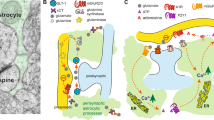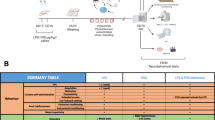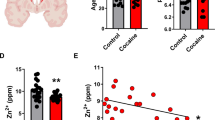Abstract
The striatum is a brain area implicated in the pharmacological action of drugs of abuse. Adenosine A2A receptors (A2ARs) are highly expressed in the striatum and mediate, at least in part, cocaine-induced psychomotor effects in vivo. Here we studied the synaptic mechanisms implicated in the pharmacological action of cocaine in the striatum and investigated the influence of A2ARs. We found that synaptic transmission was depressed in corticostriatal slices after perfusion with cocaine (10 μM). This effect was reduced by the A2AR antagonist ZM241385 and almost abolished in striatal A2AR-knockout mice (mice lacking A2ARs in striatal neurons, stA2ARKO). The effect of cocaine on synaptic transmission was also prevented by the protein tyrosine phosphatases (PTPs) inhibitor sodium orthovanadate (Na3VO4). In synaptosomes prepared from striatal slices, we found that the activity of striatal-enriched protein tyrosine phosphatase (STEP) was upregulated by cocaine, prevented by ZM241385, and absent in synaptosomes from stA2ARKO. The role played by STEP in cocaine modulation of synaptic transmission was investigated in whole-cell voltage clamp recordings from medium spiny neurons of the striatum. We found that TAT-STEP, a peptide that renders STEP enzymatically inactive, prevented cocaine-induced reduction in AMPA- and NMDA-mediated excitatory post-synaptic currents, whereas the control peptide, TAT-myc, had no effect. These results demonstrate that striatal A2ARs modulate cocaine-induced synaptic depression in the striatum and highlight the potential role of PTPs and specifically STEP in the effects of cocaine.
Similar content being viewed by others
Log in or create a free account to read this content
Gain free access to this article, as well as selected content from this journal and more on nature.com
or
References
Anderson WW, Collingridge GL (2007). Capabilities of the WinLTP data acquisition program extending beyond basic LTP experimental functions. J Neurosci Methods 162: 346–356.
Bastia E, Xu YH, Scibelli AC, Day YJ, Linden J, Chen JF et al (2005). A crucial role for forebrain adenosine A(2A) receptors in amphetamine sensitization. Neuropsychopharmacology 30: 891–900.
Blum D, Galas MC, Pintor A, Brouillet E, Ledent C, Muller CE et al (2003). A dual role of adenosine A2A receptors in 3-nitropropionic acid-induced striatal lesions: implications for the neuroprotective potential of A2A antagonists. J Neurosci 23: 5361–5369.
Borgkvist A, Fisone G (2007). Psychoactive drugs and regulation of the cAMP/PKA/DARPP-32 cascade in striatal medium spiny neurons. Neurosci Biobehav Rev 31: 79–88.
Carty NC, Xu J, Kurup P, Brouillette J, Goebel-Goody SM, Austin DR et al (2012). The tyrosine phosphatase STEP: implications in schizophrenia and the molecular mechanism underlying antipsychotic medications. Transl Psychiatry 2: e137.
Centonze D, Picconi B, Baunez C, Borrelli E, Pisani A, Bernardi G et al (2002). Cocaine and amphetamine depress striatal GABAergic synaptic transmission through D2 dopamine receptors. Neuropsychopharmacology 26: 164–175.
Cepeda C, André VM, Yamazaki I, Wu N, Kleiman-Weiner M, Levine MS (2008). Differential electrophysiological properties of dopamine D1 and D2 receptor-containing striatal medium-sized spiny neurons. Eur J Neurosci 27: 671–682.
Chen JF, Beilstein M, Xu YH, Turner TJ, Moratalla R, Standaert DG et al (2000). Selective attenuation of psychostimulant-induced behavioral responses in mice lacking A(2A) adenosine receptors. Neuroscience 97: 195–204.
Chiodi V, Uchigashima M, Beggiato S, Ferrante A, Armida M, Martire A et al (2012). Unbalance of CB1 receptors expressed in GABAergic and glutamatergic neurons in a transgenic mouse model of Huntington's disease. Neurobiol Dis 45: 983–991.
Ferrè S, Fredholm BB, Morelli M, Popoli P, Fuxe K (1997). Adenosine-dopamine receptor-receptor interaction as an integrative mechanism in the basal ganglia. Trends Neurosci 20: 482–487.
Filip M, Frankowska M, Zaniewska M, Przegaliński E, Muller CE, Agnati L et al (2006). Involvement of adenosine A2A and dopamine receptors in the locomotor and sensitizing effects of cocaine. Brain Res 1077: 67–80.
Fiorillo CD, Williams JT (2000). Selective inhibition by adenosine of mGluR IPSPs in dopamine neurons after cocaine treatment. J Neurophysiol 83: 1307–1314.
Gerdeman G, Partridge JG, Lupica CR, Lovinger DM (2003). It could be habit forming: drugs of abuse and striatal synaptic plasticity. Trends Neurosci 26: 184–192.
Goebel-Goody SM, Baum M, Paspalas CD, Fernandez SM, Carty NC, Kurup P et al (2012). Therapeutic implications for striatal-enriched protein tyrosine phosphatase (STEP) in neuropsychiatric disorders. Pharmacol Rev 64: 65–87.
Herrera-Marschitz M, Loidl CF, You ZB, Andersson K, Silveira R, O'Connor WT et al (1994). Neurocircuitry of the basal ganglia studied by monitoring neurotransmitter release. Effects of intracerebral and perinatal asphyctic lesions. Mol Neurobiol 9: 171–182.
Huttner WB, Schiebler W, Greengard P, De Camilli P (1983). Synapsin I (protein I), a nerve terminal-specific phosphoprotein. III. Its association with synaptic vesicles studied in a highly purified synaptic vesicle preparation. J Cell Biol 96: 1374–1388.
Justinova Z, Ferre S, Segal PN, Antoniou K, Solinas M, Pappas LA et al (2003). Involvement of adenosine A1 and A2A receptors in the adenosinergic modulation of the discriminative-stimulus effects of cocaine and methamphetamine in rats. J Pharmacol Exp Ther 307: 977–986.
Kiyatkin EA, Rebec GV (2000). Dopamine-independent action of cocaine on striatal and accumbal neurons. Eur J Neurosci 12: 1789–1800.
Kombian SB, Ananthalakshmi KV, Zidichouski JA, Saleh TM (2009). Substance P and cocaine employ convergent mechanisms to depress excitatory synaptic transmission in the rat nucleus accumbens in vitro. Eur J Neurosci 8: 1579–1587.
Kubrusly RC, Bhide PG (2010). Cocaine exposure modulates dopamine and adenosine signaling in the fetal brain. Neuropharmacology 58: 436–443.
Kuhar MJ, Ritz MC, Boja JW (1991). The dopamine hypothesis of the reinforcing properties of cocaine. Trends Neurosci 14: 299–302.
Kurup P, Zhang Y, Xu J, Venkitaramani DV, Haroutunian V, Greengard P et al (2010). Abeta-mediated NMDA receptor endocytosis in Alzheimer's disease involves ubiquitination of the tyrosine phosphatase STEP61. J Neurosci 30: 5948–5957.
Lazarus M, Shen HY, Cherasse Y, Qu WM, Huang ZL, Bass CE et al (2011). Arousal effect of caffeine depends on adenosine A2A receptors in the shell of the nucleus accumbens. J Neurosci 31: 10067–10075.
Lüscher C, Malenka RC (2011). Drug-evoked synaptic plasticity in addiction: from molecular changes to circuit remodeling. Neuron 69: 650–663.
Mallozzi C, Di Stasi AM, Minetti M (1997). Peroxynitrite modulates tyrosine-dependent signal transduction pathway of human erythrocyte band 3. FASEB J 11: 1281–1290.
Mallozzi C, D’Amore C, Camerini S, Macchia G, Crescenzi M, Petrucci TC et al (2013). Phosphorylation and nitration of tyrosine residues affect functional properties of Synaptophysin and Dynamin I, two proteins involved in exo-endocytosis of synaptic vesicles. Biochim Biophys Acta 1833: 110–121.
Nicola SM, Kombian SB, Malenka RC (1996). Psychostimulants depress excitatory synaptic transmission in the nucleus accumbens via presynaptic D1-like dopamine receptors. J Neurosci 16: 1591–1604.
Pascoli V, Besnard A, Hervé D, Pagès C, Heck N, Girault JA et al (2011). Cyclic adenosine monophosphate–independent tyrosine phosphorylation of NR2B mediates cocaine-induced extracellular signal-regulated kinase activation. Biol Psychiatry 69: 218–227.
Paul S, Nairn AC, Wang P, Lombroso PJ (2003). NMDA-mediated activation of the tyrosine phosphatase STEP regulates the duration of ERK signaling. Nat Neurosci 6: 34–42.
Paul S, Olausson P, Venkitaramani DV, Ruchkina I, Moran TD, Tronson N et al (2007). The protein tyrosine phosphatase STEP gates long-term potentiation and fear memory in the lateral amygdala. Biol Psychiatry 61: 1049–1061.
Popoli P, Minghetti L, Tebano MT, Pintor A, Domenici MR, Massotti M (2004). Adenosine A2A receptor antagonism and neuroprotection: mechanisms, lights, and shadows. Crit Rev Neurobiol 16: 99–106.
Rebec GV (2006). Behavioral electrophysiology of psychostimulant. Neuropsychopharmacology 31: 2341–2348.
Schumann J, Michaeli A, Yaka R (2009). Src-protein tyrosine kinases are required for cocaine-induced increase in the expression and function of the NMDA receptor in the ventral tegmental area. J Neurochem 108: 697–706.
Schiffmann SN, Fisone G, Moresco R, Cunha RA, Ferre S (2007). Adenosine A2A receptors and basal ganglia physiology. Prog Neurobiol 83: 277–292.
Shen HY, Coelho JE, Ohtsuka N, Canas PM, Day YJ, Huang QY et al (2008). A critical role of the adenosine A2A receptor in extrastriatal neurons in modulating psychomotor activity as revealed by opposite phenotypes of striatum and forebrain A2A receptor knock-outs. J Neurosci 28: 2970–2975.
Soria G, Castañé A, Ledent C, Parmentier M, Maldonado R, Valverde O (2006). The lack of A2A adenosine receptors diminishes the reinforcing efficacy of cocaine. Neuropsychopharmacology 31: 978–987.
Sun WL, Zelek-Molik A, McGinty JF (2013). Short and long access to cocaine self-administration activates tyrosine phosphatase STEP and attenuates GluN expression but differentially regulates GluA expression in the prefrontal cortex. Psychopharmacology (Berl) doi:10.1007/s00213-013-3118-5.
Tashev R, Moura PJ, Venkitaramani DV, Prosperetti C, Centonze D, Paul S, Lombroso PJ (2009). A substrate trapping mutant form of striatal-enriched protein tyrosine phosphatase prevents amphetamine-induced stereotypies and long-term potentiation in the striatum. Biol Psychiatry 65: 637–645.
Tebano MT, Pintor A, Frank C, Domenici MR, Martire A, Pepponi R et al (2004). Adenosine A2A receptor blockade differentially influences excitotoxic mechanisms at pre- and postsynaptic sites in the rat striatum. J Neurosci Res 77: 100–107.
Tozzi A, de Iure A, Marsili V, Romano R, Tantucci M, Di Filippo M et al (2012). A2A adenosine receptor antagonism enhances synaptic and motor effects of cocaine via CB1 cannabinoid receptor activation. PLoS One 7: e38312.
Uhl GR, Hall FS, Sora I (2002). Cocaine, reward, movement and monoamine transporters. Mol Psychiatry 7: 21–26.
Wu N, Cepeda C, Zhuang X, Levine MS (2007). Altered corticostriatal neurotransmission and modulation in dopamine transporter knock-down mice. J Neurophysiol 98: 423–432.
Zhang Y, Venkitaramani DV, Gladding CM, Zhang Y, Kurup P, Molnar E et al (2008). The tyrosine phosphatase STEP mediates AMPA receptor endocytosis after metabotropic glutamate receptor stimulation. J Neurosci 28: 10561–10566.
Zhang YF, Kurup P, Xu J, Carty N, Fernandez S, Nygaard HB et al (2010). Genetic reduction of the tyrosine phosphatase STEP reverses cognitive and cellular deficits in a mouse model of Alzheimer’s disease. Proc Natl Acad Sci USA 107: 19014–19019.
Zhang Y, Kurup P, Xu J, Anderson GM, Greengard P, Nairn AC et al (2011). Reduced levels of the tyrosine phosphatase STEP block beta amyloid-mediated GluA1/GluA2 receptor internalization. J Neurochem 119: 664–672.
Acknowledgements
We thank Dr Teodora Macchia for providing cocaine and Adriano Urcioli and Alessio Gugliotta for assistance with animal work.
Author information
Authors and Affiliations
Corresponding author
Rights and permissions
About this article
Cite this article
Chiodi, V., Mallozzi, C., Ferrante, A. et al. Cocaine-Induced Changes of Synaptic Transmission in the Striatum are Modulated by Adenosine A2A Receptors and Involve the Tyrosine Phosphatase STEP. Neuropsychopharmacol 39, 569–578 (2014). https://doi.org/10.1038/npp.2013.229
Received:
Revised:
Accepted:
Published:
Issue date:
DOI: https://doi.org/10.1038/npp.2013.229
Keywords
This article is cited by
-
Adenosine A2A receptor inhibition reduces synaptic and cognitive hippocampal alterations in Fmr1 KO mice
Translational Psychiatry (2021)
-
The coming together of allosteric and phosphorylation mechanisms in the molecular integration of A2A heteroreceptor complexes in the dorsal and ventral striatal-pallidal GABA neurons
Pharmacological Reports (2021)
-
Neuronal adenosine A2A receptor overexpression is neuroprotective towards 3-nitropropionic acid-induced striatal toxicity: a rat model of Huntington’s disease
Purinergic Signalling (2018)
-
Cocaine and Amphetamine Induce Overlapping but Distinct Patterns of AMPAR Plasticity in Nucleus Accumbens Medium Spiny Neurons
Neuropsychopharmacology (2016)



